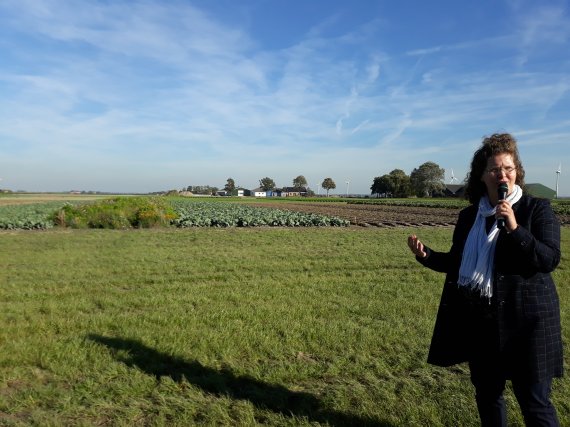Researcher Marleen Riemens explains agro-ecological crop protection. ©Albert Sikkema
WUR’s new research centre combines studies of healthy soil management with the benefits of crop diversity in the fields. The centre wants to ‘use the self-regulating capacity of ecology in agriculture,’ researcher Wijnand Sukkel of the Field Crops department at Wageningen Plant Research told interested farmers and nature organizations at the opening ceremony.
WUR stopped deep ploughing nine years ago on part of the experimental farm on Elandweg in the Flevopolder. Instead, the scientists have been experimenting with superficial ploughing and non-inversion tillage. The main benefit is that the organic content of the soil has increased substantially. That is why the WUR arable farmers now need much less fertilizer to achieve the same yields.
The second theme for the research centre is making use of crop diversity. WUR uses mixed cultivation, with strips of potatoes, sugar beets, onions, carrots, wheat, clover and flowers. Such mixed cultivation is good for biodiversity because there is always food for insects. That means fewer diseases and pests because the pests’ natural enemies are better able to survive. Yields do not suffer either, at least as long as you grow the right combinations of crops next to one another. That is one of the areas the applied research is concentrating on.
Dutch farmers are keen on monoculture, but mixed cultivation is more productive, argued Niels Anten, professor of Crop and Weed Ecology. A literature study showed that mixed cultivation needs 35 percent less land on average for the same yield. That is because the plants benefit from one another in obtaining nutrients. There are also fewer weeds, diseases and pests.
However, farmers cannot easily turn these benefits into profits. If each strip of land has a different crop, farmers can no longer use a standard approach to work the land, fertilize it, irrigate it, control disease and harvest. Each strip needs its own regimen. That is why GPS and precision agriculture are essential elements in agro-ecological arable farming. Drones and robots can be used to assess the weed situation and do the hoeing. ‘We don’t want to go back to the days of the Potato Eaters,’ said Anten, referring to Vincent van Gogh’s painting from 1885.

